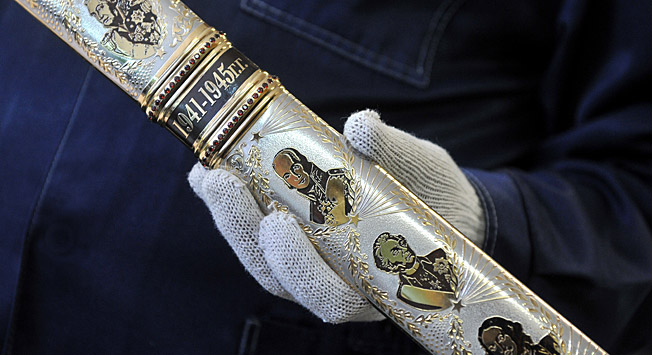Beverage Recommendation for this Post: steaming hot Americano that is so sharp and strong you could use it to cut your enemies in half
The town of Zlatoust, founded in 1754, has always payed a large part in weapon creation in Russia and supplying its military with swords in particular. Even during the 20th century when guns were more popular as a weapon, Zlatoust’s demand for swords did not falter. World War 1 saw the use of roughly “half a millions swords and cavalry lances” and World War 2 called for even more from Zlatoust in the form of combat knives. This picture of the museum, called the Arsenal, established in Zlatoust is meant to honor the craftsmanship that went into the hundreds of millions of swords that were produced in the metal working plant that makes the town so famous.

Beyond the sheer number of swords that the Zlatoust plant produced, the detail that went into the carvings and engravings found on some of the swords as well as the artistry of the hilt have earned the plant a great amount of renown. These swords were beyond compare in more than their looks but also their quality as the town became known for its use of Russian Damascus Steel, even producing some of the first cannons made of Russian steel. This particular steel was praised for its strength as well as its fashionable looks for more decorative pieces. But the town of Zlatoust was not always just a peaceful place for the plant to go about its work but in 1903 the Zlatoust workers organized a strike that was violently put down by Tsarists authorities.
Zlatoust was a town founded and built upon its metal works and sword producing, the Arsenal museum, established in 1825, tells the story of its metal work and sword making through the years. This particular pictures shows off one of the ‘hills’ of sabers and swords that can be found in the museum while on the back wall some of the more intricate pieces can be seen. The picture itself has an aesthetic appeal int he layout of the swords as well as the off centering of the focal point of the main ‘hill’ of swords. The picture certainly captures the numbers and style of the Zlatoust swords. In a time in Russia when the winds of change where ever seemingly on the horizon, in a town that was considered integral to the imperialists in terms of manufacturing weapons, the town had already seen the consequences of defying the imperial forces while protesting for more workers rights. The new ideas of the time on the harsh rule of the common people touched everywhere, even a town that was kept under tight watch by ruling forces.




Sources:
- https://www.rbth.com/defence/2015/07/06/zlatoust_the_cutting_edge_of_russias_steel_arms_production_47503.html
- https://www.rbth.com/defence/2015/07/06/zlatoust_the_cutting_edge_of_russias_steel_arms_production_47503.html
- https://www.antique-swords.eu/Q34-Crimean-War-Zlatoust-Russian-M1827-Cavalry-Troopers-Sabre.html
- https://www.wdl.org/en/item/5300/
The amount of effort put into the crafting of these swords is astounding. Do you think that, as time continued into the late 20th Century, that the manufacturing shifted more toward guns or did the wants for swords and sabers continue to flourish? Do you think the use of sabers in warfare was to retain the traditional feelings and ties to Imperial Russia, or was it something else?
LikeLike
Prior to coming across your post I never knew how detailed Russian swords were and the time that went into them. When i think of swords i never really think of Russia. So this was very cool to appreciate the time and attention to detail that they would put into there work!
LikeLike
This was very interesting! I didn’t know that swords were used in WWII. I agree that the designs on the sword are very impressive.
LikeLike
I appreciate the way you told the story of the town through its production of swords, steel, and the plant itself. I am particularly interested in the progression of weapons making that the Zlatoust plant went through. From swords to knives, and later cannons as you mention. I wonder if in more modern times, the plant has progressed even further to things such as bullets, guns, or bombs.
LikeLike
It’s incredible to learn how a state relied predominately on one town for a particular weapon. I love the detail that is put into some of the swords and knives, and I wonder if any of those detailed swords found their way onto the battlefield. Is the town still producing swords/knives today for collectors and for anyone else interested in buying them?
LikeLike
I feel bad for the poor saps who were given swords in WWII and had to go fight the Wehrmacht in places like Stalingrad, I can’t imagine that ended very well. On a more positive note, the swords are really beautiful and it shows how skilled this town was at making swords.
LikeLike
I find that there is so much irony with creating such beautiful swords, as if they were decorations rather than tools for destruction. I like how you included multiple photos of swords, showing the variety in their creation. What was the purpose of Russians continuing their purchase of swords when the weapon does not compare to the power of guns? Was it then solely for decoration?
LikeLike
I love the irony in sword making. It reminds me how sometimes the most breathtakingly beautiful animals are the most deadly. I really loved how throughout this post you included more pictures of the swords and went into great detail about them.
LikeLike
I think the swords are so cool and ornate! You did a good job mixing the history of the Zlatoust and histories of the swords and knives. I still find it fascinating that the sword and lance were used in the First World War.
LikeLike